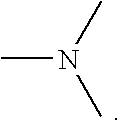Low-temperature adhesive undercoat composition
a technology of adhesive undercoat and composition, applied in the direction of lamination, paper/cardboard containers, containers, etc., can solve the problems of contaminated primer applied before, high risk of inadequate adhesion and/or severe flexibility restrictions, and time-consuming and expensive problems, and achieve good adhesion promotion
- Summary
- Abstract
- Description
- Claims
- Application Information
AI Technical Summary
Benefits of technology
Problems solved by technology
Method used
Image
Examples
Embodiment Construction
Preparation of an Illustrative Polysilane
PS-1
Corresponding to Formula (X′)
[0150]4.61 g of glycerol were initially charged in 100 g of toluene in a stirred vessel, then 20.53 g of 3-isocyanatopropyltrimethoxysilane (Geniosil® GF 40, Wacker) were added with stirring under nitrogen. Subsequently, 0.0125 g of DABCO (1,4-diazabicyclo[2.2.2]octane) was added, the mixture was stirred at 50° C. over 3 hours and left to stand under nitrogen at room temperature over 4 days, another 0.2 g of DABCO was added and the mixture was once again stirred under nitrogen at 70° C. over three days. No free isocyanate groups were detectable any longer by titrimetric means. The mixture was used in the amount specified in Table 1 as PS-1.
Production of Illustrative Adhesive Undercoat Compositions
[0151]The compositions were stirred in a stirred vessel under nitrogen according to the data in Table 1 and introduced into tight-sealing aluminum bottles and used immediately for the adhesion tests.
TABLE 1Composition...
PUM
| Property | Measurement | Unit |
|---|---|---|
| temperature | aaaaa | aaaaa |
| temperature | aaaaa | aaaaa |
| temperature | aaaaa | aaaaa |
Abstract
Description
Claims
Application Information
 Login to View More
Login to View More - R&D
- Intellectual Property
- Life Sciences
- Materials
- Tech Scout
- Unparalleled Data Quality
- Higher Quality Content
- 60% Fewer Hallucinations
Browse by: Latest US Patents, China's latest patents, Technical Efficacy Thesaurus, Application Domain, Technology Topic, Popular Technical Reports.
© 2025 PatSnap. All rights reserved.Legal|Privacy policy|Modern Slavery Act Transparency Statement|Sitemap|About US| Contact US: help@patsnap.com



